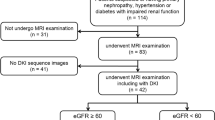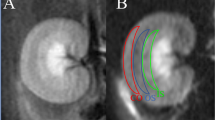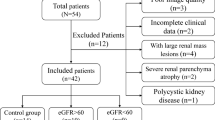Abstract
Objectives
To evaluate the value of renal diffusion kurtosis imaging (DKI) in the diagnosis of early diabetic nephropathy (DN) in a rat model.
Materials and methods
Forty male Zucker diabetic fatty rats that spontaneously developed type 2 diabetes mellitus (DM) and 20 age-matched nondiabetic lean Zucker rats were included. Renal DKI scans and histological examinations were performed on the rats in batches at the end of the 4th, 8th, 12th, 16th, and 20th week after DM model was built. Based on renal histopathological appearance, included animals were divided into three groups: a nondiabetic control group, a DM group without DN, and an early DN group. Mean kurtosis (MK) and mean diffusivity (MD) values of renal cortex and medulla were analyzed statistically.
Results
MK values of renal cortex and medulla tended to increase from the control group to the early DN group, respectively, while MD values tended to decrease. The cutoff MD and MK values of renal cortex and medulla showed different values in discriminating early DN from controls. Among them, cutoff MK value of medulla of 0.62 was the best parameter (sensitivity, 93.9%; specificity, 96.4%; and area under the curve, 0.95). For discriminate early DN from DM without DN and DM without DN from controls, cutoff MK value of renal cortex or medulla achieved an area under the curve of 0.76–0.85.
Conclusions
MR DKI may be valuable for the noninvasive detection of early DN, and MK value might serve as a more sensitive biomarker of early DN than MD value.
Key Points
• In this article, diffusion kurtosis imaging (DKI) was used to detect the changes in the kidneys due to early diabetic nephropathy (DN).
• MR DKI may be valuable for the noninvasive detection of early DN.
• The mean kurtosis values of renal cortex and medulla might serve as a more sensitive biomarker of early DN than the mean diffusivity values.


Similar content being viewed by others
Abbreviations
- AZ :
-
Area under the curve
- DKI:
-
Diffusion kurtosis imaging
- DM:
-
Diabetes mellitus
- DN:
-
Diabetic nephropathy
- DTI:
-
Diffusion tensor imaging
- MD:
-
Mean diffusivity
- MK:
-
Mean kurtosis
- ROC:
-
Receiver operating characteristic curve
- ROI:
-
Region of interest
- ZDF:
-
Zucker diabetic fatty
References
Arneth B, Arneth R, Shams M (2019) Metabolomics of type 1 and type 2 diabetes. Int J Mol Sci 20(10):2467
Vasanth Rao A/LBVR, Tan SH, Candasamy M, Bhattamisra SK (2019) Diabetic nephropathy: an update on pathogenesis and drug development. Diabetes Metab Syndr 13(1):754–762
Mogensen CE, Christensen CK, Vittinghus E (1983) The stages in diabetic renal disease. With emphasis on the stage of incipient diabetic nephropathy. Diabetes 32:64–78
Shields J, Maxwell AP (2010) Managing diabetic nephropathy. Clin Med (Lond) 10(5):500–504
Gray SP, Cooper ME (2011) Diabetic nephropathy in 2010: alleviating the burden of diabetic nephropathy. Nat Rev Nephrol 7(2):71–73
Martin H (2011) Laboratory measurement of urine albumin and urine total protein in screening for proteinuria in chronic kidney disease. Clin Biochem Rev 32:97–102
Klimontov VV, Korbut AI (2018) Normoalbuminuric chronic kidney disease in diabetes. Ter Arkh 90(10):94–98
Xiong Y, Sui Y, Zhang S et al (2019) Brain microstructural alterations in type 2 diabetes: diffusion kurtosis imaging provides added value to diffusion tensor imaging. Eur Radiol 29(4):1997–2008
Jensen JH, Helpern JA (2010) MRI quantification of non-Gaussian water diffusion by kurtosis analysis. NMR Biomed 23(7):698–710
Rosenkrantz AB, Padhani AR, Chenevert TL et al (2015) Body diffusion kurtosis imaging: basic principles, applications, and considerations for clinical practice. J Magn Reson Imaging 42(5):1190–1202
Pentang G, Lanzman RS, Heusch P et al (2014) Diffusion kurtosis imaging of the human kidney: a feasibility study. Magn Reson Imaging 32(5):413–420
Huang Y, Chen X, Zhang Z et al (2015) MRI quantification of non-Gaussian water diffusion in normal human kidney: a diffusional kurtosis imaging study. NMR Biomed 28(2):154–161
Tervaert TW, Mooyaart AL, Amann K et al (2010) Pathologic classification of diabetic nephropathy. J Am Soc Nephrol 21(4):556–563
Baliyan V, Das CJ, Sharma R, Gupta AK (2016) Diffusion weighted imaging: technique and applications. World J Radiol 8(9):785–798
Hueper K, Hartung D, Gutberlet M et al (2012) Magnetic resonance diffusion tensor imaging for evaluation of histopathological changes in a rat model of diabetic nephropathy. Invest Radiol 47(7):430–437
De Santis S, Gabrielli A, Palombo M, Maraviglia B, Capuani S (2011) Non-Gaussian diffusion imaging: a brief practical review. Magn Reson Imaging 29(10):1410–1416
Jensen JH, Helpern JA, Ramani A, Lu H, Kaczynski K (2005) Diffusional kurtosis imaging: the quantification of non-Gaussian water diffusion by means of magnetic resonance imaging. Magn Reson Med 53(6):1432–1440
Cakmak P, Yağcı AB, Dursun B, Herek D, Fenkçi SM (2014) Renal diffusion-weighted imaging in diabetic nephropathy: correlation with clinical stages of disease. Diagn Interv Radiol 20(5):374–378
Chen X, Xiao W, Li X, He J, Huang X, Tan Y (2014) In vivo evaluation of renal function using diffusion weighted imaging and diffusion tensor imaging in type 2 diabetics with normoalbuminuria versus microalbuminuria. Front Med 8(4):471–476
Wang YC, Feng Y, Lu CQ, Ju S (2018) Renal fat fraction and diffusion tensor imaging in patients with early-stage diabetic nephropathy. Eur Radiol 28(8):3326–3334
Lu L, Sedor JR, Gulani V et al (2011) Use of diffusion tensor MRI to identify early changes in diabetic nephropathy. Am J Nephrol 34(5):476–482
Thoeny HC, de Keyzer F, Oyen RH, Peeters RR (2005) Diffusion-weighted MR imaging of kidneys in healthy volunteers and patients with parenchymal diseases: initial experience. Radiology 235(3):911–917
Ries M, Jones RA, Basseau F, Moonen CT, Grenier N (2001) Diffusion tensor MRI of the human kidney. J Magn Reson Imaging 14(1):42–49
Kasiske BL, O’Donnell M, Keane WF (1992) The Zucker rat model of obesity, insulin resistance, hyperlipidemia and renal injury. Hypertension 19:I110–I115
Funding
This study was supported by the National Natural Science Foundation of China (Grant No. 81541127).
Author information
Authors and Affiliations
Corresponding author
Ethics declarations
Guarantor
The scientific guarantor of this publication is Haiying Zhou.
Conflict of interest
The authors of this manuscript declare no relationships with any companies whose products or services may be related to the subject matter of the article.
Statistics and biometry
No complex statistical methods were necessary for this paper.
Informed consent
Approval from the institutional animal care committee was obtained.
Ethical approval
Institutional Review Board approval was obtained.
Methodology
• Prospective
• Diagnostic study
• Performed at one institution
Additional information
Publisher’s note
Springer Nature remains neutral with regard to jurisdictional claims in published maps and institutional affiliations.
Rights and permissions
About this article
Cite this article
Zhou, H., Zhang, J., Zhang, X.M. et al. Noninvasive evaluation of early diabetic nephropathy using diffusion kurtosis imaging: an experimental study. Eur Radiol 31, 2281–2288 (2021). https://doi.org/10.1007/s00330-020-07322-6
Received:
Revised:
Accepted:
Published:
Issue Date:
DOI: https://doi.org/10.1007/s00330-020-07322-6




